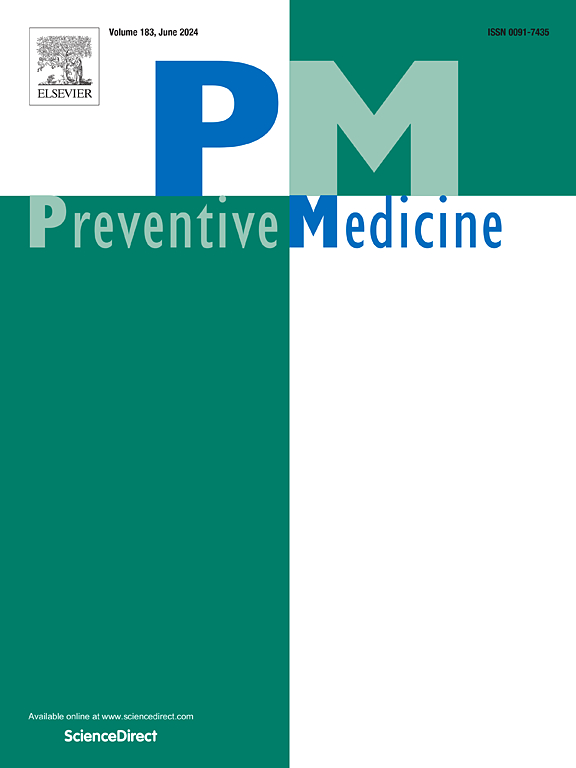Physical activity and subjective cognitive decline among U.S. older adults: A population-based analysis of the 2023 behavioral risk factor surveillance system
IF 3.2
2区 医学
Q1 MEDICINE, GENERAL & INTERNAL
引用次数: 0
Abstract
Objectives
This study sought to assess associations between physical activities and subjective cognitive decline (SCD) among older adults aged 65 years and above.
Methods
Data were drawn from the 2023 Behavioral Risk Factor Surveillance System and included older adults who completed the cognitive decline module. Multivariable regression models were performed to assess the relationship between self-reported physical activity levels and SCD. We further conducted stratified analyses of 11 types of primary physical activity.
Results
Among 73,339 older adults, 33.1 % reported no physical activity, 14.7 % reported insufficient physical activity, 28.4 % met one guideline only, and 23.8 % met both guidelines. Walking (39.7 %), gardening or yard work (8.6 %), and bicycling (2.7 %) were the most commonly reported primary physical activities. As compared to those without physical activities, older adults who engaged in physical activity and met guidelines were less likely to report SCD (only one guideline, Adjusted Prevalence Ratio[95 % CI] = 0.87[0.78, 0.96]; both guidelines, APR[95 % CI] = 0.81[0.73, 0.90]). Participation in certain primary activity types, combined with meeting at least one physical activity guideline, was associated with lower odds of SCD.
Conclusions
Our findings highlight the importance of meeting physical activity guidelines to mitigate the risk of SCD among older adults and reveal varying effects by primary activity types.
美国老年人的身体活动和主观认知能力下降:2023年行为风险因素监测系统的人口分析
目的:本研究旨在评估65岁 及以上老年人体力活动与主观认知能力下降(SCD)之间的关系。方法:数据来自2023年行为风险因素监测系统,包括完成认知能力下降模块的老年人。采用多变量回归模型评估自我报告的体力活动水平与SCD之间的关系。我们进一步对11种主要体育活动进行了分层分析。结果:在73339名老年人中,33.1% %报告没有PA, 14.7 %报告身体活动不足,28.4 %仅满足一个指南,23.8 %满足两个指南。步行(39.7% %)、园艺或庭院劳动(8.6% %)和骑自行车(2.7 %)是最常见的主要体育活动。与没有体育活动的老年人相比,从事体育活动并符合指南的老年人报告SCD的可能性较小(只有一条指南,调整患病率[95 % CI] = 0.87[0.78,0.96];两条指南,APR[95 % CI] = 0.81[0.73,0.90])。参加某些主要活动类型,并至少满足一项体育活动指南,与较低的SCD发生率相关。结论:我们的研究结果强调了满足身体活动指南对于降低老年人SCD风险的重要性,并揭示了主要活动类型的不同效果。
本文章由计算机程序翻译,如有差异,请以英文原文为准。
求助全文
约1分钟内获得全文
求助全文
来源期刊

Preventive medicine
医学-公共卫生、环境卫生与职业卫生
CiteScore
7.70
自引率
3.90%
发文量
0
审稿时长
42 days
期刊介绍:
Founded in 1972 by Ernst Wynder, Preventive Medicine is an international scholarly journal that provides prompt publication of original articles on the science and practice of disease prevention, health promotion, and public health policymaking. Preventive Medicine aims to reward innovation. It will favor insightful observational studies, thoughtful explorations of health data, unsuspected new angles for existing hypotheses, robust randomized controlled trials, and impartial systematic reviews. Preventive Medicine''s ultimate goal is to publish research that will have an impact on the work of practitioners of disease prevention and health promotion, as well as of related disciplines.
 求助内容:
求助内容: 应助结果提醒方式:
应助结果提醒方式:


